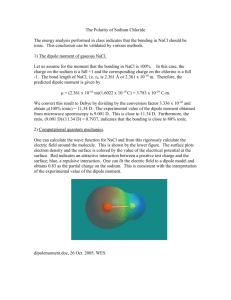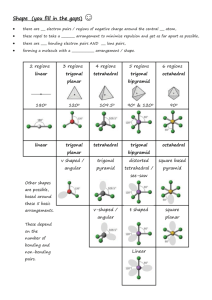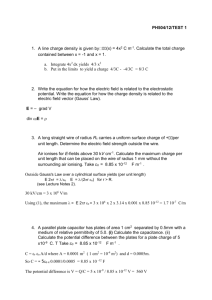How Dividing a Magnetic Moment and Distributing
advertisement
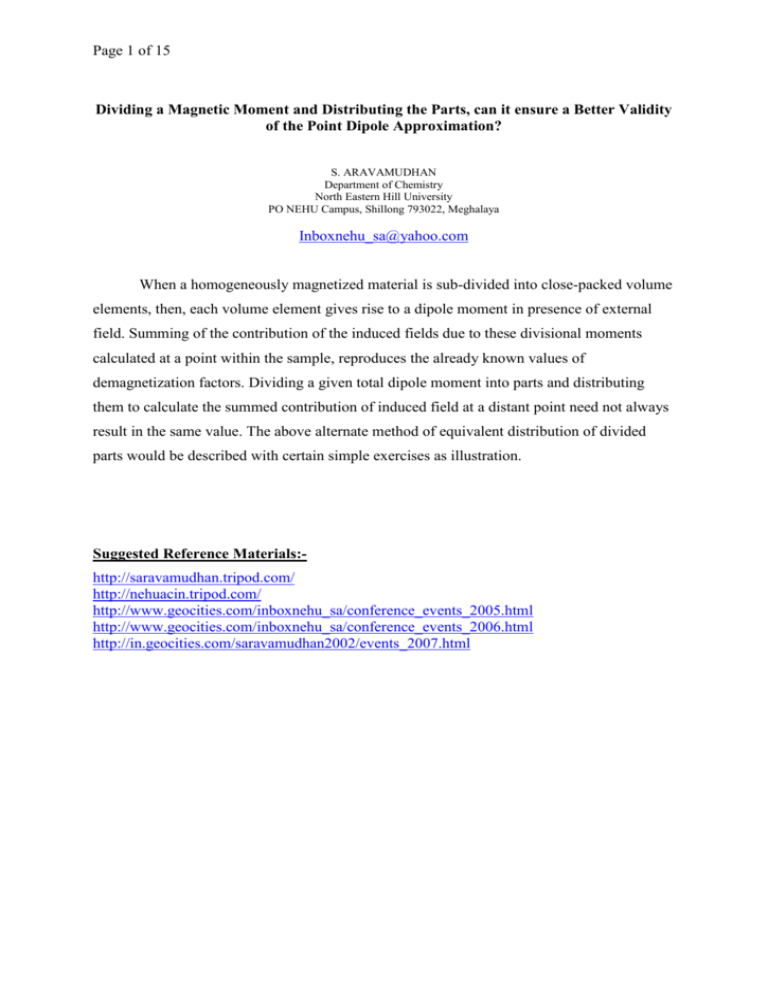
Page 1 of 15
Dividing a Magnetic Moment and Distributing the Parts, can it ensure a Better Validity
of the Point Dipole Approximation?
S. ARAVAMUDHAN
Department of Chemistry
North Eastern Hill University
PO NEHU Campus, Shillong 793022, Meghalaya
Inboxnehu_sa@yahoo.com
When a homogeneously magnetized material is sub-divided into close-packed volume
elements, then, each volume element gives rise to a dipole moment in presence of external
field. Summing of the contribution of the induced fields due to these divisional moments
calculated at a point within the sample, reproduces the already known values of
demagnetization factors. Dividing a given total dipole moment into parts and distributing
them to calculate the summed contribution of induced field at a distant point need not always
result in the same value. The above alternate method of equivalent distribution of divided
parts would be described with certain simple exercises as illustration.
Suggested Reference Materials:http://saravamudhan.tripod.com/
http://nehuacin.tripod.com/
http://www.geocities.com/inboxnehu_sa/conference_events_2005.html
http://www.geocities.com/inboxnehu_sa/conference_events_2006.html
http://in.geocities.com/saravamudhan2002/events_2007.html
Page 2 of 15
1. Abstract (100 words) on page-1
2. Introduction: page-2
3. A description of subdivided volume elements: pages 2- 4
4. Calculating Demagnetization factor: pages 4-11
5. Discussion of the criteria for subdividing: pages 11-12
6. Conclusion: page 12
7. Appendix-A (more details for the aspects in Section-2) pages 13-15
INTRODUCTION:
The table of demagnetization factors, which are available, consists of values
calculated by a procedure of mathematical Integration, starting from defining “infinitesimally
small” charge circulations giving rise to dipole moments placed at the centre of circulation.
Thus such infinitesimal charge circulation is placed over the entire extent of the specimen and
integration carried out of the induced field at a given point in the specimen due to all such
infinitesimal dipole moments. If it is recalled here that a procedure of integration is
effectively a summing over all the infinitesimal quantities, then the question arises as to
whether within a certain tolerance, the infinite number of dipole moments envisaged can
possibly find an equivalent distribution of finite number dipole moments arising from the
entire material. Then the calculation of the contribution to the induced field due to all these
finite number of dipoles would require finite number of calculations for summing, and the
limit of infinite number of calculations and additions would not be encountered. The
approach then would be to merge the cells in the mesh of infinite number of cells to reduce
the count appropriately to finite number of cells in the mesh, which describes the material
specimen without leaving any material away from counting for the contribution. Alternately,
to get such a set of finite number of dipoles, first, the single dipole due to the bulk
susceptibility of the entire specimen-volume is to be considered as having been placed at an
appropriate electrical centre of gravity within the specimen. Then devise appropriate criteria
for a subdivision for this single total dipole moment to distribute the resulting finite number
of dipoles to appropriate locations within the specimen. Either merging the cells or subdividing the total, requires a rearrangement, correspondingly, either to get the equivalent
origin for a set of distributed locations or for a given single location to get a set of distributed
origins to be equivalent to the singular location. With respect to the induced field at a given
point from all these dipoles using the point dipole approximation, placing effectively a single
dipole at an origin need not result in the same value as the distributed situation for the dipoles
that constitute the totality of dipoles. If it does, then it would be as if the point dipole
approximation is valid for the effective single dipole as much as for the distributed dipoles, in
which case there should not be any requirement for the “subdividing” procedure. In the
following, this aspect of the necessity for subdividing the specimen into smaller volume
elements would be illustrated for the compliance with the point dipole approximation to
calculate induced field contribution at a given point.
A DESCRIPTION OF SUBDIVIDED VOLUME ELEMENTS
In Figure 1, the illustration depicts the trends of induced field values for a dipole moment of a
given magnitude, split into two equal parts and placed at symmetrically distant points on both
sides of the original location. The data is on the Table-1 for this graphical illustration. An
elaboration of the materials discussed in this section can be found at Appendix-A
Page 3 of 15
Table-1:
For moment value ‘-2 units’ Induced field values at
‘R’ values
2
4
8
32
R
R-0.5
R+0.5
[(R-0.5)+(R+0.5)]/2
-0.5
-0.0625
-0.00781
0.00012207
-0.256
-0.0439
-0.00651
0.000116523
-1.18519
-0.09329
-0.00948
-0.000127976
-0.720595
-0.068595
-0.007995
-0.00012225
Figure-1
35
1.4
32
1.2
30
25
0.8
0.6
distance
ind.field (arb.unit)
1
0.4
20
15
0.2
10
0
8
-0.2
0
2 45
8
10
15
20
25
30
32
35
distance
5
4
2
0
R
R+0.5
R-0.5
1
[(R+0.5)+(R-0.5)]/2
An equation of the type
i=ii /R3i [1-(3.RRi /R5i)] -------------Equation -1
Can be used for the calculation of the induced field (a shielding tensor ‘σ’ multiplied by the
applied field value gives the induced field in the tensor forms.) For an ‘isotropic
susceptibility’, characterizing the system can give the induced field component value along
the field direction by the much simpler formula (derivable from the above by a
simplification), as follows:
Page 4 of 15
Magnetic
Field
{χ . (1-3.COS2θ)} / (R)3 ---------Equation 2
For the above calculation χ=-2 was used and θ = 0° where the θ is the
angle between the distance vector and the direction of magnetic field.
When the R-value increases, the splitting distance of 1 unit becomes
relatively smaller and the consequence on the induced field values is
obvious form the graphical results. It can be noted that the above
equation for the point dipole approximation is more valid at such larger
distances.
Moment μ=χ. H
R
Figure-2
For a different perspective on this situation, the following illustration is included without
much description. In this case, the volume 'v' of the spherical volume element considered
here for the calculation is 1.17E-24 c.c. The radius 'r' of this volume element is
0.000000006544 cm 0.6544E-08cm which is 0.6544 A° using this radius value and the
equation for the volume of sphere (4/3).π.r3 the value of 'v' has been calculated. The value of
the susceptibility of the spherical volume used is 6E-29 cgs units. The calculated values are at
Lattice periodicities (one-dimensional) of 10A°; 11A°; 12A° and 13A°; 9A°; 8A°; 7A°,
(Figure-3). These are plotted graphically in Figure-4.
Figure-3
2.00E-07
Distances of Point where the induced
fields for all periodicities tend to become
negligible,. Since the L.C. values are from
7 to 13, this distance corresponds to the
range of 18A° to 35A°, when the
susceptibility & the resulting magnetic
moment is enclosed in a volume of
0.6544A°
1.80E-07
1.60E-07
1.40E-07
1.20E-07
1.00E-07
8.00E-08
6.00E-08
4.00E-08
2.00E-08
0.00E+00
1
Figure-4
2
10A
11A
3
12A
13A
9A
4
8A
7A
With the above remarks on the consequences of “splitting dipoles” and calculating
contribution to the induced field at a distant point, the Calculation of the Demagnetization
factor is described in the following section.
CALCULATING DEMAGNETIZATION FACTOR:
In the context of a demagnetization factor, it is necessary to remark that a single
demagnetization factor value is obtainable for the whole specimen when (i) the specimen is a
homogeneous substance with uniform volume susceptibility through out the sample and (ii)
the shape of the specimen is an ellipsoid of revolution, a sphere being a typical special case.
Splitting the magnetic moment would correspond to subdividing the specimen into smaller
volume elements, each describable in terms of an associated moment in presence of the field.
Page 5 of 15
If the totality of the specimen material is accounted for by the corresponding summation of
the volume elements, the single dipole moment of the entire specimen material would have
been equivalently subdivided, and the dipole moments of the individual elements would be
placed at the appropriate central location within the respective volume elements. The
susceptibility of the volume elements would be proportional to the volume and which in turn
determines the magnitude of the moment. Thus from the equation 2 the following criteria can
be inferred: the subdivided volume elements will all be at different distances from the point
where the induced filed is calculated. If the subdivision were such that the volume elements
are equal in size, then the entire specimen would be sub divided into specified number of
equal volume elements. This would result in the obvious inappropriate splitting as illustrated
in the previous section. On the other hand noting that the divided susceptibility values would
be proportional to the volume, if the shape of the volume elements is spherical, then the
susceptibility would be a product of (4πr3/3)•χv with r being the radius of the spherical,
divided element and χv being the volume susceptibility of the homogeneous specimen. Then,
it is noteworthy that the r3 factor in the numerator is as much cube dependence as the R3
factor in the denominator. Note that the ‘r’ and ‘R’ are not related by any specified ratio.
Therefore, same ‘r’ value occurs for the varying ‘R’ values in the case of equally subdivided
elemental case. If the (‘r’/ ‘R’) value can be held constant, then all subdivided elements along
a radial vector with the same θ value can all contribute the same value irrespective of the
variation of ‘R’. In such a case, with these criteria of r/R constant, would it be possible to
subdivide the entire volume into smaller elements in such a way that the elements are all
closely packed to account for the undivided material within that shape? If such a coincidence
occurs, then possibly there can be a way out of the complication due to splitting dipoles. Then
how many dipoles ‘n’ can be closed packed along a vector R, θ and φ?
n
Radius vector ‘R’,’θ’ and ‘φ’
i
Ri+1 = Ri + ri + ri+1 ----Eq.1
If Ri / ri = C, C=constant for all ‘i’ values
then, Ri = C x ri and [Ri+1 / Ri] = [ri+1 / ri ]
From Eq.1 [Ri+1 / ri+1] = [Ri / ri+1] + [ri / ri+1] + 1
[Ri+1 / ri+1] = [(C x ri) / ri+1] + [ri / ri+1] + 1
[Ri+1 / ri+1] = [ (C+1) { ri / ri+1}] + 1
C = [ (C+1) { ri / ri+1}] + 1
(C -1) = (C +1) [Ri / Ri+1]
Ri+1 = Ri (C+1)/(C-1)
Ri = Ri-1 (C+1)/(C-1)
R2 = R1 (C+1)/(C-1)
R3 = R2 (C+1)/(C-1)
Therefore, R3 = R1 (C+1)/(C-1) (C+1)/(C-1) = R1 {(C+1)/(C-1)}2
Rn = R1 {(C+1)/(C-1)}n-1 Hence, Rn / R1 = {(C+1)/(C-1)}n-1
Log(Rn / R1) = n-1 [log{(C+1)/(C-1)}]
‘n’ = 1+ {log(Rn / R1)}/ [log{(C+1)/(C-1)}]
4
3
R4 = ‘Ri+1’
2
1
R3 = ‘Ri’
The possibility of close packing of
subdivided spheres of the specimen is
considered in the next three pages, for
which the equation derived above is used.
FIGURE-5
Page 6 of 15
Commensurate with the Susceptibility the
magnetic moment M would be in accordance
with the equation
M = χv x H
Susceptibility is ISOTROPIC
Z-Axis; the Direction of Magnetic Field: H
In these calculations, VOLUME
Susceptibility is used. That is specified
as χ cm3
A typical value for Organic molecules
(Diamagnetic) can be a convenient
value and -2.855 x 10 -7 units can be
typical per cc. of the material
Polar Angle θ
R
FIGURE-6
Is the distance of the
magnetic moment from
the point (where the
induced field value is to
be known).
The distance is along the
radial Vector specified
by its Polar angle
r is the radius of the spherical magnetized material
specifically demarcated.
(4/3) π r3 will be the spherical volume of the material at a
distance R contributing at the
point of origin in the illustration on the left
The equation for induced field based on a dipolar model would then be
σ = -2.855 x 10-7 x [(4/3) π r3] χv x (1- 3 cos2 θ) / R3
From the above equation it is obvious that along this radial vector with the
specified polar angle if spherical volume elements of the material are placed such
that they all have the ‘radius- r’ to ‘distance-R’ ratio the same, then every one of
such sphere would contribute the same induced
field at the specified point.
Page 7 of 15
Line defined by Polar
angle θ / direction of radial
vector
Sph.closepack
Distance from center of each sphere
25.00
20.00
15.00
10.00
5.00
0.00
32.5
37.5
42.5
47.5
52.5
57.5
Constant=45.836
FIGURE-7
Quantitative ILLUSTRATION of Close
packing with the constraint ri /Ri = Constant
A Rotation by 360° results in a cone in conformity with the filling
above and the cone is filled with the spheres closely packed. This is cone
is a section of the full sphere and the sphere can be well envisaged with
the closely filled spheres. The specimen then is left with the voids due to
the regions not filled by the spheres. Hence, the material, in the actual
specimen, corresponding to the amount filling the void must be taken
into account and its contribution to induced field at the point.
Page 8 of 15
Z-Axis; The Direction of magnetic field
This circular base of the cone with
apex angle equal to the polar angle θ,
has radius equal to ‘R sin θ’: See
Textbox below
Radial Vector defined by a
polar angle θ w.r.to Z
Rn
Polar
angle
R1
FIGURE-8
R1
Equation for calculating the number of
spheres, the dipole moments, along the
radial vector is as given below:
Rn
R1
n 1
C 1
log
C 1
log
Rn
With “C= Ri / ri, i=1, n”
For a sphere of radius =0.25 units, and the polar angle
changes at intervals of 2 .5˚
There will be 144 intervals. Circumference= 2π/4 so
that the diameter of each sphere on the circumference
= 0.0109028; radius = 0.0054514
C = R/r = 0.25 / 0.0054514 = 45.859779
[46.859779/44.859779] = 1.04458334
Log (1.0445834) = 0.0189431 (r/R) 3=1.0368218e-5
=0.000010368218
Using above equation ‘n’ along the vector length is calculated, for the direction with polar angle θ.
Which is ‘σ’ per spherical magnetic moment x number of such spheres ‘n’.
σθ =σ x n. At the tip of the vector, there is circle along which magnetic moment have to be
calculated. This circle has radius equal to ‘R sinθ’. The number of dipoles along the length of the
circumference = 2 π R sinθ/2.r = π R/ r sinθ. Again, (R/ r) is a constant by earlier criteria.
Page 9 of 15
Along each of the radial vector direction of polar angle θ, spheres can be closely packed with
the specified constraint. It is this constraint, which brings in the simplicity that, every one of
the spheres along a radial vector contributes the same induced filed at the specified point
(site) within the material. Thus if the value for one sphere is known, and the number of
closely packed spheres are calculated (as given by the equation stated earlier), then, the total
contribution from that direction can be obtained by multiplying by the number ‘n’ of such
spheres.
Let the contribution of (one) i-th sphere along the vector direction θ be = σi,θφ
Then the contribution from ‘n’ spheres would be = n x σi,θφ = σθφ
This is only along the line of a radial vector, which is for a fixed φ. The φ dependent
contributions for a given polar angle, θ can be obtained by recognizing the rotational
symmetry around the magnetic field direction and this above value of σθ would be the same
for all radial vectors on the surface of rotational cone with apex angle θ. If the circle
described by the base of the cone is considered its radius would be, ‘R sinθ’ where R is the
radial distance to the surface of the sphere from the site. By calculating the circumference of
the circle described by the base, (to be 2 x π x R sinθ) and dividing the circumference
length by the diameter of the Sphere in that base layer, which is 2 x r, the number of such
closely packed spheres on the circumference can be known. This number [(2πRsinθ)/2r]
would be the number of radial vectors with the same polar angle θ and all the radial vectors
would contribute each the same as calculated for one of vector. Thus the final value for the
given polar angle would be
σθ = [(2πRsinθ)/2r] x σθφ . This procedure is repeated for all values of θ discretely at
known (specified before) interval and sum over the polar angles would give the total
contribution from the entire specimen. R/r value would be the same as the value set as
constraint.
For one sphere = σi,θφ For ‘n’ spheres = n x σi,θφ = σθφ
Summed for all azimuthal angle values for the given polar angle = σθ .
Summing Over all polar angles thus gives final total contribution from the specimen material
corresponding to spherical filling = σ. Since the spheres at their respective points can be
replaced by cubes with the side equal to the diameter of that sphere, there can be no further
void to account for. This step increases the magnetic moment at each point by the ratio of the
cube to sphere volume. i.e.,
(8 x r3) / (4/3 x π x r3) = 1.909859. Final value σT = 1.909859 x σ
r
σT = [NINNER-NOUTER] x (4π x χv) with
NINNER = 0.3333 (stands for value for spherical cavity)
From the above relation
NOUTER can be calculated for the calculated σT
2r
Page 10 of 15
FIGURE-9A
FIGURE-9B
The figures 9A & 9B, and the considerations related to the induced field distributions,
calculations by point dipole approximation have been the subject matter in the contributions
at several of the conferences and symposia, which are well documented, in the following
websites, and the links specified in those WebPages:
http://saravamudhan.tripod.com/
http://nehuacin.tripod.com/
http://www.geocities.com/inboxnehu_sa/conference_events_2005.html
http://www.geocities.com/inboxnehu_sa/conference_events_2006.html
http://in.geocities.com/saravamudhan2002/events_2007.html
Page 11 of 15
Inner ellipsoid
a/b=0.25
demgf= 0.697
Outer ellipsoid
a/b=0.25
demagf= 0.708
Ellipsoid
Outer a/b=0.25
Inner a/b=0.25
demagf=0.333
Outer sphere
Inner sphere
a/b=1
demagf=0.333
From the standard tables demagnetization factor for a/b=0.2: =0.750484
for a/b=0.3: =0.661350
interpolation yields for 0.25:
= 0.705
FIGURE-10
417
It is only conventional in material physics consideration to have a
spherical (Lorentz) cavity while calculating the demagnetization factors
for regular outer shapes of the magnetized specimen. By the procedures
used in this work,it is a matter of simple alteration in sequence in which
certain equations defining the shpes and forms are considered which
makes it possible,without any resulting complications in the calculation,to
get values for Facotrs, based on the definition of demagnetization
factors,as reported above by applying the shapes inside out . This seems
to be very favourable for studying shapes, with added susceptibility
reagents in membrane-media, by spin-echo NMR techniques.The details
are deferred to future presentations.
DISCUSSION OF THE CRITERIA FOR SUBDIVIDING
The contents of the figures 1, 3, and 4, and the materials included in Appendix-A would
make evident the following consequence of splitting dipoles into equal parts and distributing
them about the origin of the total moment. The simplest symmetrical criterion for distributing
the subdivided moments would be to place them in symmetrical disposition around the
original undivided dipole centre to get the electrical centre of gravity of the moments to be
same before and after the division. By this criterion, the equally divided parts may be placed
at equal intervals of distances around which bring some parts away from the point where the
induced field is calculated and equal numbers nearer to that site. Displacing the equal parts by
same interval of distance away and near would ensure the electrical centre of gravity to be
retained as the same, but the dipole which is away would contribute much less and the nearer
part contribute much more (due to inverse cube dependence on distance). Moreover, the sum
of the contributions would not be the same as that of undivided dipole. This brings in the
arbitrariness and makes the division (splitting) of dipole questionable.
Thus, it is required to divide the dipoles as weighted parts (and not equal parts) in such a way
that the electrical centre of gravity is retained. In addition, the requirements for the validity of
point dipole approximation must be fulfilled for each divided part at its location to which it is
distributed. Then the contribution of induced field from each divided part would be the same
at a specified distant point. That is, “the magnitude of divided dipoles is equal” is not a
necessary criterion. But, irrespective of its size and distance ( for same θ and φ) each divided
part contribute the same value of induced field so that simply multiplying by the number of
parts into which the original dipole is subdivided, the total induced filed value is obtained. As
much as the sample specimen has a homogeneity consideration for the susceptibility value
through out the specimen, a kind of homogeneity in contribution (equal contribution) is held
as constraint while subdividing, instead of the division into equal parts. Ensuring this kind of
“homogeneity/uniformity” of induced filed contribution, makes the induced field value
independent of the distance. The criterion of point-dipole approximation is built-in in the
choice of the (R/r) factor with the “uniformity” of contribution. This seems to simulate
factually the single “undivided” moment contribution when the dipole approximation is valid.
But, the fact is, in reality, “with the undivided dipole, the point dipole approximation is not
valid”.
Page 12 of 15
It is essentially the distance dependence, which is critical for the validity of the point dipole
approximation. The angular dependence hence is to the same extent as it is in the case of
undivided case of moments. Thus for a given set of (θ, φ) values, meaning along a given
radial vector, the number of dipoles closely packed would depend upon the ratio of (C=R/r)
chosen. Depending upon this value of ‘C’, the number of dipoles along each of the radial
vector, ‘nθ, φ’ would vary. For the spheres packed closely along the line the center of all
spheres of varying radii lie on the radial vector. These spheres would have radii such that it
would be possible to draw a cone containing these spheres, which would have an apex at the
site where the induced filed contribution is required. The axis of the cone would be the radial
vector. Which means that the material in the given set of such spheres are contained in the
spherical specimen within a solid angle “Δω” ( see Figure-7) where as the material of the
entire specimen can be included only if the solid angle ‘4π’ is covered. Hence for each set of
(θ, φ), a ‘Δωθ,φ’ and an ‘nθ, φ’ are associated with every of one of the nθ, φ spheres contributing
the same induced field value.
Then for all conical sections (packed radially adjacent, and closely packed to cover the solid
angle 4π) the (θ, φ) associated would determine the angular dependence and the number ‘n’
would determine the dipoles which all contribute the same induced field at the conical apex
where the contribution is calculated. When spheres are closely packed, there would be voids
in the closed packed structure. This would mean the materials in the volume of the voids (for
the corresponding magnetic moments) have to be taken into account which is accomplished
by describing a cube enclosing each of the spheres, the ‘side-length’ being the same as the
radius of that corresponding sphere. This has been explained already earlier in the previous
section.
CONCLUSION
It is known that a division of a magnetized material into smaller volume elements would not
provide in general a unique possibility for assessing the induced field distribution calculated
by applying the point dipole approximation to sum the contributions from the extent of the
material. In spite of such established ambiguities, it has been shown that a criterion for
subdividing the materials into smaller elements is possible; by which, a induced dipole
moment can be associated corresponding to every subdivided elemental-volume and, then the
point dipole approximation can be employed. Thus, a convenient alternate method could be
evolved to calculate demagnetization factors. This procedure yields values, which are
reasonably accurate and are the same as the values available from the standard table of
demagnetization factors.
This alternate procedure, which is very convenient to calculate induced filed contributions, it
has been found to enable the calculation of demagnetization factors for the combination of
shapes of inner semi-micro volume element and the outer macroscopic specimen shape as in
Figure-10. More over, with the confidence thus ensured for the criteria of subdividing
magnetized materials, it has been found that this procedure enables the applicable ranges and
chemical contexts for the use of point dipole approximation. As can be found from the
descriptions above the induced field distributions can be calculated without invoking surface
charges and hence, from the point of view of applications in chemistry, the appreciation of
induced field distributions in chemistry gets better and more elegant with the point dipole
approximation. Specifically, interpretation of spectral parameters in terms of molecular
electronic structure seems to be rendered much less ambiguous with this magnetic dipole
model.
Page 13 of 15
APPENDIX: A - page1
Charge circulation, Magnetic Moment and the point dipole approximation
+m
N
‘d’
-m
=2 d m
The approximated
radius of this charge
cloud has to be taken
into account while
deriving the “distance”
factor d
S
In case of either the electrical or the magnetic
dipole moments a simple arrow can serve the
purpose to indicate the presence of a “Dipole”
as located at a given point
While considering the Field due to
the dipole moment at ‘R’ it is
possible to consider the two poles
separately and find the
R
contribution from each pole and
sum up to get the total.
Instead of each time considering the poles of dipoles separately, it is possible to get an
equation for this total at R by a single equation using the dipole moment. This implies that the
distance d has to be considered while calculating the field at a distance R. It turns out that if
d R then, the calculations result in unrealistic values. For validity, the value of R >> d.
This means R 10 d. This is referred to as the POINT-DIPOLE approximation. It is a
consideration as to at what values of the distance R the given dipole can be arising from a
single point and not from the consideration of the length d characteristic for the value of the
moment |μ|.
2
Dipole origin
1
At the point 2 “outside the cloud where the ‘radius’
would be small compared to distance ‘R’ to the point
The point dipole approximation is more valid than at
1 “within’ the cloud itself. In fact such an approach to
aplly POINT dipole approximation at 1 would be not
at all justifiable.
Page 14 of 15
APPENDIX: A – page2
Single dipole
split into Two halves
Dipole:
ΔR
R
Induced field
Site:
Induced field values
on Y axis in graph
1.60E-09
1.20E-09
16
14
12
10
8
6
4
2
0
Range of
ΔR values
for the
validity
0
1
8.00E-10
2
R
3
R+1
4
R-1
5
6
site
Range of ΔR values for
which approximations
are questionable
4.00E-10
0.00E+00
1
2
3
4
5
1
R
R+x
2
3
4
5
R-x
The INSET in the graph above is schematically enlarged in the drawing above which
indicates how the single dipole is split and placed to have the same average distance as the
un-split single dipole. Will the sum of contribution of the split halves be the same as the
single un-split dipole? As seen in the left side of the graph, the contribution of the half placed
below the average distance increases more rapidly with distance than the decrease of the
contribution due to the half placed symmetrically above the average single dipole point.
However, even when two split halves are considered, the effective magnitude of the
vectorially added halves is the same as the un-split single dipole.
Materials given above in this SHEET should be added details to the considerations in
SHEET-10 of the poster presented at the 6th NSC of the CRSI held in IIT/Kanpur during Feb.
2004: http://www.geocities.com/saravamudhan1944/crsi_6nsc_iitk.html
Page 15 of 15
APPENDIX: A – page3
As pointed out earlier the induced field contribution at a distance R from the dipole varies as
1/R3. Therefore, the strength of the moment μ would be in the numerator, while the
denominator would have the factor R3. The charge cloud which gives rise to this dipole
moment is confined to a region which can be included completely within a sphere of
minimum radius ‘r’, then the pictorially this situation can be envisaged as follows.
Charge
Cloud
r
•μ
R
+
Only in the limit of R >> r the
sum of the contributions of the
two halves becomes equal to that
of the contribution of the single
moment. This condition ensures
that the inter-moment distances are
small compared to the R and the
contributions of the split moments
vary more or less proportional to
the moment values. Hence with
respect to the contributions at this
site the distributed moments form
a continuum.
•
•
This is the detailed perspective of the contents of previous pages, and explains why for
demagnetization factors, considering discrete distribution of magnetic moments would not
be possible. That would be a question of calculating contributions from points within the
cloud-region, at a point within the same region. The type of condition as above cannot be
realized.


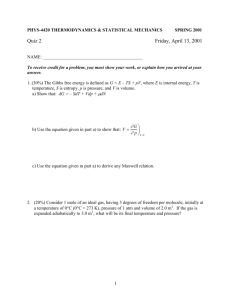
![[Answer Sheet] Theoretical Question 2](http://s3.studylib.net/store/data/007403021_1-89bc836a6d5cab10e5fd6b236172420d-300x300.png)
